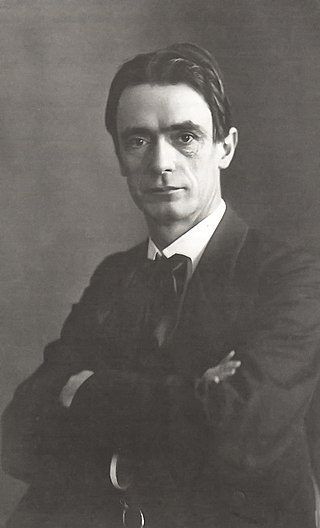Related Research Articles
Anthroposophy is a spiritual movement which was founded in the early 20th century by the esotericist Rudolf Steiner that postulates the existence of an objective, intellectually comprehensible spiritual world, accessible to human experience. Followers of anthroposophy aim to engage in spiritual discovery through a mode of thought independent of sensory experience. While much of anthroposophy is pseudoscientific, proponents claim to present their ideas in a manner that is verifiable by rational discourse and say that they seek precision and clarity comparable to that obtained by scientists investigating the physical world.

Rudolf Joseph Lorenz Steiner was an Austrian occultist, social reformer, architect, esotericist, and claimed clairvoyant. Steiner gained initial recognition at the end of the nineteenth century as a literary critic and published works including The Philosophy of Freedom. At the beginning of the twentieth century he founded an esoteric spiritual movement, anthroposophy, with roots in German idealist philosophy and theosophy. His teachings are influenced by Christian Gnosticism. Many of his ideas are pseudoscientific. He was also prone to pseudohistory.
The General Anthroposophical Society is an "association of people whose will it is to nurture the life of the soul, both in the individual and in human society, on the basis of a true knowledge of the spiritual world." As an organization, it is dedicated to supporting the community of those interested in the inner path of schooling known as anthroposophy, developed by Rudolf Steiner.
Anthroposophic medicine is a form of alternative medicine based on pseudoscientific and occult notions. Devised in the 1920s by Rudolf Steiner (1861–1925) in conjunction with Ita Wegman (1876–1943), anthroposophical medicine draws on Steiner's spiritual philosophy, which he called anthroposophy. Practitioners employ a variety of treatment techniques based upon anthroposophic precepts, including massage, exercise, counselling, and substances.

Ita Wegman co-founded Anthroposophical Medicine with Rudolf Steiner. In 1921, she founded the first anthroposophical medical clinic in Arlesheim, known until 2014 as the Ita Wegman Clinic. She also developed a special form of massage therapy, called rhythmical massage, and other self-claimed therapeutic treatments.
Karl König was an Austrian paediatrician who founded the Camphill Movement, an international movement of therapeutic intentional communities for those with special needs or disabilities.

Elisabeth Vreede was a Dutch mathematician, astronomer and anthroposophist.
Ernst Lehrs was a German anthroposophist, Waldorf teacher, lecturer and writer.
Rudolf Hauschka was an Austrian chemist, author, inventor, entrepreneur and anthroposophist.
Willem Frans Daems, PhD was a pharmacist, anthroposophist, pianist, teacher and editor.
Hans Krüger was a pharmacist, anthroposophist, botanist, lecturer and researcher.
Wilhelm Pelikan was a German-Austrian chemist, anthroposophist, pharmacist, gardener and anthroposophical medicine practitioner.
Oskar Schmiedel was a pharmacist, anthroposophist, therapist, Goethean scientist and theosophist.
Peter Selg is a German psychiatrist. He was born in Stuttgart and studied medicine in Witten-Herdecke, Zurich, and Berlin. Until 2000, he worked as the head physician of the juvenile psychiatry department of Herdecke hospital in Germany. Selg is director of the Ita Wegman Institute for Basic Research into Anthroposophy and professor of medicine at the Alanus University of Arts and Social Sciences (Germany). He lectures extensively and is the author of numerous books.
Wilhelm Rath was a German writer, translator, bio-dynamic farmer and anthroposophist. He is best known for his research and translations of certain medieval mystics, notably the Friend of God from the Oberland, Bernard Silvestris, Alanus ab Insulis and John of Hildesheim.
Herbert Hahn was a German teacher and Anthroposophist.
Jakob Streit was a Swiss author, teacher and anthroposophist. Besides this he worked as musician and choirmaster as well as conductor and dramaturg
George Adams Kaufmann, also George Adams and George von Kaufmann, was a British mathematician, translator and anthroposophist. He travelled widely, spoke several languages and translated many of Rudolf Steiner’s lectures into English. Through his studies in theoretical physics, he contributed to the expansion and development of the natural sciences as extended by the concepts of anthroposophy.
Johannes Tautz (30 September 1914 in Koblenz am Rhein to 13 March 2008 in Dortmund, was a historian, religious scholar, Anthroposophist, author and Waldorf teacher. He concerned himself with a better understanding of National Socialism and with questions of education in the twentieth century.
Dankmar Bosse is a German geologist.
References
- ↑ http://www.iaap.org.uk/downloads/pioneers-in-anthroposophic-pharmacy-june-2006.pdf Pioneers in Anthroposophic Pharmacy Accessed on: 2009-13-4